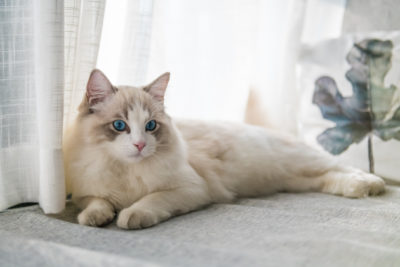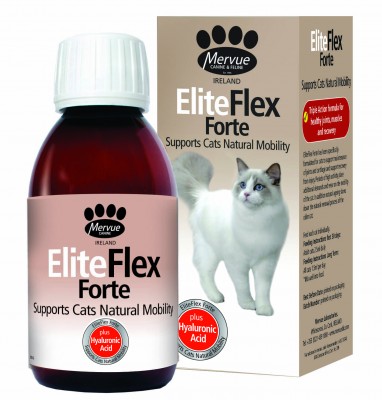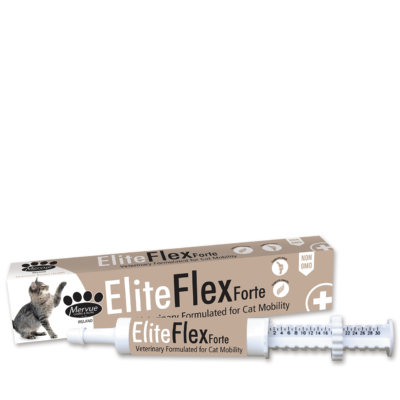- +353 21 422 0397
- info@mervue.ie
- Mon - Fri: 09:00 - 17:00
 Arthritis is the medical term used to describe joint inflammation. Joint inflammation can result from a variety of causes, but most commonly it is a result of wear and tear of cartilage and bone in joints. As with humans, arthritis and joint wear and tear is more common in older cats but is by no means unique to older cats. Cats are both predators and predated and for this reason they are masters of hiding pain and demonstrating vulnerability to their predators. Therefore, until recently arthritis was not considered a major problem in cats. Alarmingly, recent studies looking at the X-rays has demonstrated that 60% to more than 90% of cats have evidence of arthritis in their limb joints. the shoulders, hips, elbows, knees (stifles) and ankles (tarsi) are the most commonly affected joints.
Arthritis is the medical term used to describe joint inflammation. Joint inflammation can result from a variety of causes, but most commonly it is a result of wear and tear of cartilage and bone in joints. As with humans, arthritis and joint wear and tear is more common in older cats but is by no means unique to older cats. Cats are both predators and predated and for this reason they are masters of hiding pain and demonstrating vulnerability to their predators. Therefore, until recently arthritis was not considered a major problem in cats. Alarmingly, recent studies looking at the X-rays has demonstrated that 60% to more than 90% of cats have evidence of arthritis in their limb joints. the shoulders, hips, elbows, knees (stifles) and ankles (tarsi) are the most commonly affected joints.
 The signs of arthritis in cats are often very subtle, since cats are masters of hiding discomfort and pain. A cat will limit its activity to minimise pain rather than limp as a dog might. Signs that would suggest that your cat may suffer from arthritis include: reduced activity (spending more time sleeping, hunting less and not playing so much); reduced grooming (poor hair coat, or excessive grooming over painful joints, long claws from lack of activity) reduced mobility (e.g. tentative about jumping up or down, difficulty using litter tray or cat flap). Some cats will demonstrate surprising temperament changes which can alter the cat human bond negatively (e.g. irritability when being stroked, isolation and avoiding interaction).
The signs of arthritis in cats are often very subtle, since cats are masters of hiding discomfort and pain. A cat will limit its activity to minimise pain rather than limp as a dog might. Signs that would suggest that your cat may suffer from arthritis include: reduced activity (spending more time sleeping, hunting less and not playing so much); reduced grooming (poor hair coat, or excessive grooming over painful joints, long claws from lack of activity) reduced mobility (e.g. tentative about jumping up or down, difficulty using litter tray or cat flap). Some cats will demonstrate surprising temperament changes which can alter the cat human bond negatively (e.g. irritability when being stroked, isolation and avoiding interaction).
International Cat Care and ISFM (the veterinary division of the charity) have produced a ‘mobility check list’ which owners can download from here and use to see if there have been any changes in their cat that may be indicative of arthritis or joint pain.
Arthritis in cats is often quite advanced by the time it is diagnosed. Many cats will require anti-inflammatory drugs to help to control the pain and inflammation, but there are several other things that owners can do to assist their cat with arthritis and mobility issues.
In the early stages of arthritis, cats may benefit from nutritional supplementation and in advanced cases nutritional supplements in conjunction with painkillers will also benefit cats.
 ELITEFLEX FORTE for Cats contains several elements which are beneficial to joints. Glucosamine and chondroitin are the building blocks of cartilage and supplementation may help to repair damaged cartilage. Vitamins E and C are antioxidants and will help to counteract the oxidative damaged caused by inflamed and dying cells in the joints. Hyaluronic acid is an important component of joint fluid and contributes to the lubrication and thickness of the joint fluid. Arthritic joints often have decreased amounts of hyaluronic acid because of inflammation. MSM (methylsulfonylmethane) is a natural compound produced by kelp in the ocean and is reported to have an anti-inflammatory effect as well as an effect on increasing the strength of the ligaments, tendons and joint capsule that surrounds the joints. ELITEFLEX FORTE for Cats also contains the amino acids isoleucine, leucine and valine which are important sources of energy for the muscles that support and operate the joints.
ELITEFLEX FORTE for Cats contains several elements which are beneficial to joints. Glucosamine and chondroitin are the building blocks of cartilage and supplementation may help to repair damaged cartilage. Vitamins E and C are antioxidants and will help to counteract the oxidative damaged caused by inflamed and dying cells in the joints. Hyaluronic acid is an important component of joint fluid and contributes to the lubrication and thickness of the joint fluid. Arthritic joints often have decreased amounts of hyaluronic acid because of inflammation. MSM (methylsulfonylmethane) is a natural compound produced by kelp in the ocean and is reported to have an anti-inflammatory effect as well as an effect on increasing the strength of the ligaments, tendons and joint capsule that surrounds the joints. ELITEFLEX FORTE for Cats also contains the amino acids isoleucine, leucine and valine which are important sources of energy for the muscles that support and operate the joints.
 ELITEFLEX FORTE for Cats is available in a paste and liquid formulation:
ELITEFLEX FORTE for Cats is available in a paste and liquid formulation:
The liquid formulation should be mixed into wet food at a rate of 2.5ml daily for the first 30 days followed by 1.5ml indefinitely as required. Most cats will benefit from long term supplementation of mobility supplements.
The paste formulation can be administered either directly into food or smeared on the cats’ lips or feet, so they lick it off. 2.5ml should be administered daily for the first 30 days and this should then be reduced to 1ml daily thereafter.
Environmental changes: in all cases of arthritis in cats it is enormously beneficial for the cat to modify its environment to minimise the demands made on painful joints. Examples of environmental modification include introducing soft beds and placing them near radiators; considering ramps to facilitate the cat accessing window stills or its favourite sleeping place; considering the placement of food and water bowls to minimise jumping, reducing; reducing the height and increasing the size of the litter tray to avoid accidents; and undertaking more frequent grooming, cleaning and claw cutting because cats like to be clean.
Copyright © 2019 Mervue Laboratories. All Rights Reserved.